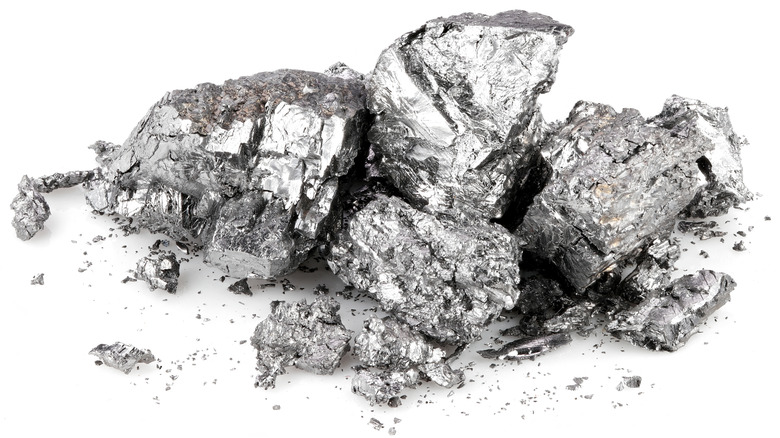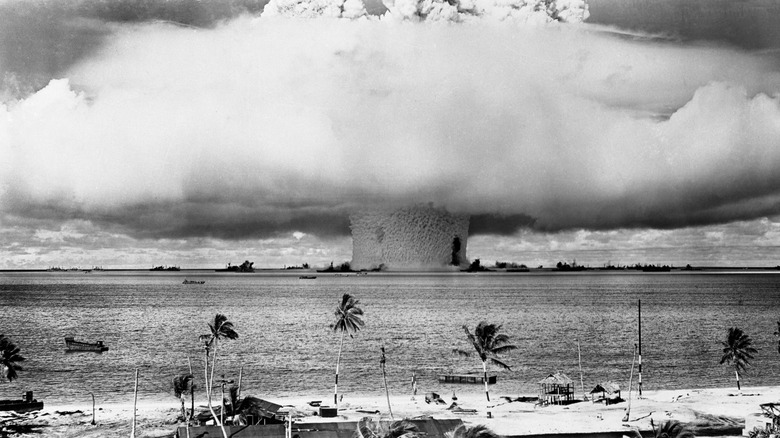What Beryllium Disease Does To Your Body, According To Science
Beryllium (Be) is one of those elements that many people might think sounds kinda-sorta familiar — less so than elements like hydrogen, oxygen, sodium, potassium, etc. — and that's the end of it. But as sites like the Royal Society of Chemistry, Thought Co, and Cleveland Clinic explain, people encounter beryllium all the time. It's in airplanes, cars, phones, computers, spot welders, golf clubs, sockets, thermostats, fiber optic cables, x-ray machines, CAT scanners, missiles, satellites, and much, much more. Beryllium is naturally steel-gray, light, brittle, has a high melting point, is non-magnetic, and is most often mixed with copper to make an alloy suitable for a variety of applications — particularly nuclear weapons. In fact, as the Atomic Heritage Foundation says, the core of the very first atomic bomb detonated during the Manhattan Project was composed in part of beryllium.
But in addition to powering our very technology-laden lives — and potentially incinerating our bodies — beryllium is also something you don't want to handle with your bare hands, or breathe in. As Live Science explains, beryllium is extremely toxic, especially when airborne. Nineteenth-century researchers could have told us the same thing, seeing as it was the habit of early scientists to lick and taste things they discovered, per Chemicool. Cleveland Clinic tells us that beryllium disease, caused by inhaling beryllium dust — more properly "beryllium-induced lung disease" — can destroy and scar your lungs, cause fatigue, fever, coughing, difficulty breathing, joint pain, and yes, cancer.
A sweet-tasting, toxic substance
Beryllium came to the attention of the scientific world in 1798 thanks to the work of French chemist Louis Nicolas Vauquelin. He found beryllium in beryl, an emerald-hued stone mined by ancient Romans in Egypt as far back as 2,000 years ago, per the U.S. Geological Survey. Britannica says that the ancient Egyptians likely knew about the stone and mined it, as well.
Vauquelin identified beryllium in 1798, but it took until 1828 for other chemists to isolate beryllium from beryl. Back then chemists didn't just observe and chemically manipulate minerals, however, they tasted them. Beryllium, as it turns out, tastes sweet, which is where it gets its original name "glucinium," related to the word glucose. Pub Chem says that the International Union of Pure and Applied Chemistry (IUPAC) gave beryllium its modern name in 1949.
The Jefferson Lab says the beryllium's toxicity gives it its sweet taste, and Live Science says that researchers have to exercise care when handling it. However, Cleveland Clinic says that beryllium is most dangerous if pulverized and inhaled, and cites two types of beryllium lung disease resulting from exposure: acute (short-term) and chronic (long-term). Chronic beryllium disease starts with symptoms similar to an allergic response and may cause lung cells to cluster into granulomas — nodules — that cause infections and scarring. At worst, the National Cancer Institute says that workers exposed to beryllium dust show an increased risk of developing lung cancer.
Early beryllium atomic bomb use
We mentioned that beryllium has a lot of applications in technology and the sciences, particularly when it comes to nuclear power and weaponry. Thought Co, for instance, says that beryllium plays an important role in making nuclear fuel more efficient, as it allows fuel to burn at lower temperatures and thereby operate for a longer period of time. That's a rather benign use of the element. Back during the days of the early J. Robert Oppenheimer-era atomic bomb testing, though, Global Security explains that scientists lined the interior of plutonium cores with beryllium shields that reflected particles back to the core. This is how early bombs reached critical mass and exploded.
The first nuclear detonation occurred on July 16, 1945, at Los Alamos, New Mexico. Author and journalist Alisa Lynn Valdés M.S. posted on Twitter that the U.S. government gave locals 24 hours to leave Los Alamos before bulldozing their homes, and the Los Angeles Times reported no one was warned in nearby towns as the mission was top secret. Valdés claimed they then moved in to conduct nuclear tests, hiring the displaced Hispanic men to handle beryllium. These men then apparently died from the aforementioned chronic beryllium disease, which Cleveland Clinic says takes 30 to 40 years to manifest.
Since 2005, a group called The Tularosa Basin Downwinders Consortium has been dedicated to finding justice for Americans who were affected by the toxic chemical fallout and collecting "data on the cancers and other diseases that plague the communities surrounding the Trinity Test on July 16, 1945."


